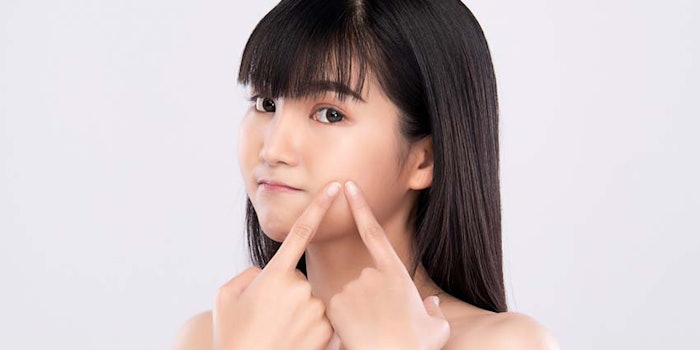
Acne was a major concern before COVID-19 but is even more so now. According to a report by Technavio, the anti-acne cosmetics market is projected to expand by US $443.62 million, a CAGR of 4%, between 2019 and 2023.
Donning face masks affords critcal protection but also has given rise to "maskne." In relation, we offer the following brief literature review on recent anti-acne and antimicrobial research.
pH Dependence of Glycolic Acid's Antibacterial Activity
Valle González, E.R., Jackman, J.A., Yoon, B.K., Mokrzecka, N. and Cho, N.-J.; Scientific Reports; doi: https://doi.org/10.1038/s41598-020-64545-9
To determine to what extent glycolic acid can effectively inhibit the Gram-positve bacterium Cutibacterium acnes (previously Propionibacterium acnes), which is implicated in acne, these authors evaluated its efficacy in the pH range of 3 to 4.5. The greatest potency against C. acnes was observed at pH 3, and findings indicated under the appropriate pH, anti-acne formulations with glycolic acid concentrations as low as 0.2% are suitable for over-the-counter applications. Furthermore, the nonionic form of glycolic acid was more active than the anionic form.
Burdock Root Peptide Fraction for Anti-acne Effects
Miazga-Karska, M., Michalak, K. and Ginalska, G.; Molecules; https://doi.org/10.3390/molecules25092027
These authors explored the antibacterial potential of low molecular weight (< 5000 Da) peptides (Br-p) isolated from Arctium lappa L. (burdock) roots. Antibacterial activity was assessed using acne strains via diffusion tests, MIC and MBC. The fraction of 46 Br-p peptides showed a narrow spectrum of activity against Gram-positive acne bacterial strains. The selectivity index (SI) value for the tested Propionibacterium strains ranged from 160 to 320. These studies confirmed the anti-acne properties of the isolated peptide fraction and susggested its potential for skin care.
Nanocarriers Deliver Anti-acne Benefits
Patel, R. and Prabhu, P.; International J Pharmaceutics; https://doi.org/10.1016/j.ijpharm.2020.119140
According to this article abstract, the topical delivery of anti-acne actives is hindered by their poor aqueous solubility and inadequate penetration across stratum corneum. To overcome this, nanocarriers can facilitate the topical delivery of anti-acne actives alone or in combination with mechanisms including occlusion to promote skin hydration, sustained drug release to decrease dosing frequency, follicular targeting and protection for labile actives against degradation. Smart nanocarriers also can selectively deliver anti-acne ingredients in response to stimuli present solely at the disease site. Nanocarriers also have been explored in photothermal and photodynamic therapies for acne. This work provides a review.
Microemulsion-delivered Cinnamaldehyde and Berberine to Treat Acne vulgaris
Gull, A., Ahmed, S., Ahmad, F.J., Nagaich, U. and Chandra, A.; J Drug Delivery Sci and Tech; https://doi.org/10.1016/j.jddst.2020.101835
The present work aimed to deliver a combination of cinnamaldehyde (CA) and berberine chloride (BER) to treat Propionibacterium acnes-induced acne. CA and BER were loaded at differing concentrations in a clove oil-based microemulsion and converted into a hydrogel (CA-BER-ME-Gel). The anti-acne efficacy in the treatment groups was shown to be significantly better than the disease control group. Based on this study, the authors concluded cinnamaldehyde and berberine loaded CA-BER-ME-Gel can be an effective prescription alternative for the treatment of acne vulgaris.
Artocarpus heterophyllus L (Jackfruit) Anti-acne Cream
Shufyani, F., Yudistira, S., Mabrur, M. and Sari, A.P.; Jurnal Penelitian Farmasi & Herbal; https://ejournal.delihusada.ac.id/index.php/JPFH/article/view/258
In this study, Artocarpus heterophyllus L (jackfruit) leaf extract, which is known for its therapeutic treatment of acne, was incorporated at varying concentrations into a cream. Its stability and antibacterial activity against Propionibacterium acne was assessed. Two the five formulas exhibited physical stability and were most effective against the acne bacteria; with an average inhibition zone of 9.5 mm.
Moronecidin and Temporin-1Dra Antimicrobial Peptides Against Acne, Inflammation
Wu, Y., Zhang, G. and Zhou, M.; Peptide Science; https://doi.org/10.1002/psc.3255
According to these researchers, nonresidual antimicrobial peptides with low‐drug resistance are potential anti‐acne agents. Thus, the peptides temporin‐1Dra and moronecidin were synthesized and tested for antimicrobial activity against P. acnes in vitro and in vivo. The peptides inhibited the growth of Escherichia coli, Staphylococcus aureus, Candida albicans and P. acnes. The minimal inhibitory concentrations (MICs) of temporin‐1Dra and moronecidin to P. acnes were 30 μM and 10 μM, respectively. Both peptides also exhibited strong resistance to heat and pH, and no cytotoxicity to HaCaT cells. The authors concluded moronecidin, in particular, could thus be developed as a potential natural anti‐acne agent for cosmetics.









